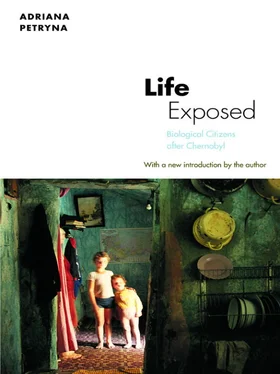In scientific circles, Chernobyl has been valued as a kind of “experiment,” allowing scientists to corroborate or refute biomedical data concerning the long-term health consequences of nuclear exposure (“Chernobyl’s Legacy” 1996:653). In this analysis, I take the meaning of experiment in a wider sense, and examine how technical interventions aimed at containing the aftermath introduced new uncertainties in social and scientific arrangements. Hans-Jorg Rheinberger has observed that this kind of experiment is manipulative, “designed to give unknown answers to questions which themselves we are not yet able clearly to ask” (1995:110). Experimental systems are “machines for making the future” (Jacob 1988, cited in Rheinberger 1995:110). This definition provides an ethnographically rich alternative to the more traditional notion of experiments as “singular, well-defined instances embedded in the elaboration of a theory and performed in order to corroborate or to refute certain hypotheses” (109). Rather than achieving an isolated instance of certainty as the result of a rigidly controlled environment, experimental systems produce new and unanticipated resources in environments where little if anything is held constant.
In the Soviet setting, whole populations were understood as “new resources.” “Our social psychology would be empty,” wrote a leading Soviet social psychologist, “without the remarkable experiment of our people led by [the Party] in the reformation of the psychology and consciousness of the Soviet people.” For these scientists, human nature itself was a newly liberated resource, open to tinkering with within an experimental paradigm. Thus, social psychologists sought to demonstrate the accumulation of “new facts and laws of socio-mental [ sotsial’no-psikhicheskii ] phenomena.” Consciousness, epistemes, and mental phenomena were cogenerated within such a paradigm; they expressed themselves in the form of “socially conditioned reflections of reality” or “reflections of objective reality in the form of sensations, ideas, thoughts, feelings, voluntary actions, and the like” (Kuzmin, quoted in Slobin 1966:87).
That human nature could be engendered experimentally, that novel cognitive capacities could be constructed and accumulated over time, speaks to the profoundly interventionist character of science in everyday Soviet life. What has consistently come as a surprise to Western observers is the extent to which Soviet and post-Soviet individuals could describe the constructedness of their psychological capacities with such accuracy and without relegating them to the realm of an unknown or an unconscious (Inkeles and Bauer 1959:142).
The ability to unmask behavior as socially conditioned, the capacity to “disown” the psychological structures one inhabits, has been characterized as a by-product of Soviet pedagogical programs that focused almost exclusively on ensuring the dominance of the collective over the individual (Kharkhordin 1999). Mastery of these kinds of unmasking abilities is clearly evident in the way post-Soviet scientists related to some international scientific experts who framed Chernobyl as a largely psychosocial phenomenon; this framing was interpreted as telling an incomplete story and obscuring more complicated truths. In a speech commemorating the tenth anniversary of the Radiation Research Center in 1996, for example, I listened as the former Ukrainian minister of health at the time of the Chernobyl disaster toasted the progress of Chernobyl science. His audience included scientists and clinicians who worked tirelessly with leukemia, cardiac, and acute radiation sickness patients (among others) several floors above the meeting hall. With his glass raised, the slightly inebriated bureaucrat and scientist burst out, “Friends! Yesterday we were ignorant, today we are mental cases, and tomorrow, who knows what science will bring! ”
These words resonated remarkably (and uncannily) with English philosopher Alfred North Whitehead’s 1926 observation, “Heaven knows what seeming nonsense may not to-morrow be demonstrated truth” (Whitehead, cited in Arendt 1989:290). Whitehead’s comment is a call for grounding scientific abstractions in their human consequences and realities. When such grounding is absent, persons, their behaviors, and their natures run the risk of conforming to illusory truths. And this loss of touch with reality was precisely what the former minister’s mordant humor mocked. That he could draw humor from his own record of ethical neglect speaks to the essence of tragedy—to what Whitehead so aptly described as “the solemnity of the remorseless working of things” (1926:11). [34] Anatolii Romanenko is widely known as having played a pivotal role in pathologizing his countrymen as “radiophobic” in a Soviet campaign to paper over the scale of the disaster. He presided over the May Day Parade that all were required to attend on May 1, when levels of radiation peaked in Kyiv. He did not issue health warnings that day.
In this moment, postsocialist scientists have before them the opportunity to transcend a personhood founded on a collective adherence to objective reality; to imagine and speak from different ethical locations; to deploy moral critiques of a science-as-human-progress paradigm.
Persons occupying “lower” orders of the social scale—the collective farmers, policemen, and industrial workers who became sufferers or persons claiming disability—deployed critiques of their own, albeit in much more subversive ways, as a means of asserting their human rights claims. They took up their roles—in many creative ways—as the “epistemic murk” of scientific progress (Taussig 1987). Where absolute truths prevailed, so did ignorance; where emphasis on the precision of facts ruled, so did imprecision. This is not to suggest these individuals were “anti-science.” Rather, they became masters of the reality of what science did not know about them. Ignorance, understood as a form of self-assertion, is fundamental to scientific progress too.
A brief excursus into the processes by which modern forms of self-assertion could prevail over a period of self-abnegating absolutism may prove useful here. In The Legitimacy of the Modern Age , Hans Blumenberg devotes two chapters to the importance of ignorance in the story of progress in modernity. He takes his example from the formulations of a medieval speculative metaphysician, Nicholas of Cusa. [35] The Cusan’s free speculations opposed a late medieval emphasis on God’s omnipotence and hence were considered antichurch and suspicious.
In his treatise, the Docta Ignorantia , the Cusan opposed the Scholastic belief in knowledge as “the end of a summation process of what is humanly knowable” and replaced it with a “novel cognitive procedure.” Blumenberg interprets the Cusan’s work as an attempt to provide “something like a mundane and human compensation for theological absolutism.” The Docta reflects “skeptical resignation vis-à-vis the metaphysical pretensions of the age with an element of indefinite expectation of a knowledge that could no longer have the form it had had hitherto” (1983:492).
For Blumenberg, “ignorance” conveys a spectrum of meaning, from a “mere misfortune of the pretension to truth” to a “positivized negativity” (493). Ignorance does not represent a negative state of knowledge. Nor does it imply a simplistic lack of access to or unwillingness to recognize the truth. It refers to “a praxis, a method, a path to a certain sort of attitude” (490). The Cusan’s example demonstrates how the modern idea of scientific progress will be the sum total of something like ignorance, knowledge, and imprecision as an important “intervening phase between simpler truths and more complex ones ” (504; emphasis added). [36] “For a theoretical attitude, imprecision could never be an ultimate characteristic of its objects, but only an intervening phase between the supposed precision of an imagined stellar ‘simplicity’ and a future, more complex precision of superimposed periodicities…. Imprecision is not the speculatively anticipated and necessary state of affairs but rather first of all a scandalous contingent fact” (Blumenberg 1983:504).
Читать дальше












